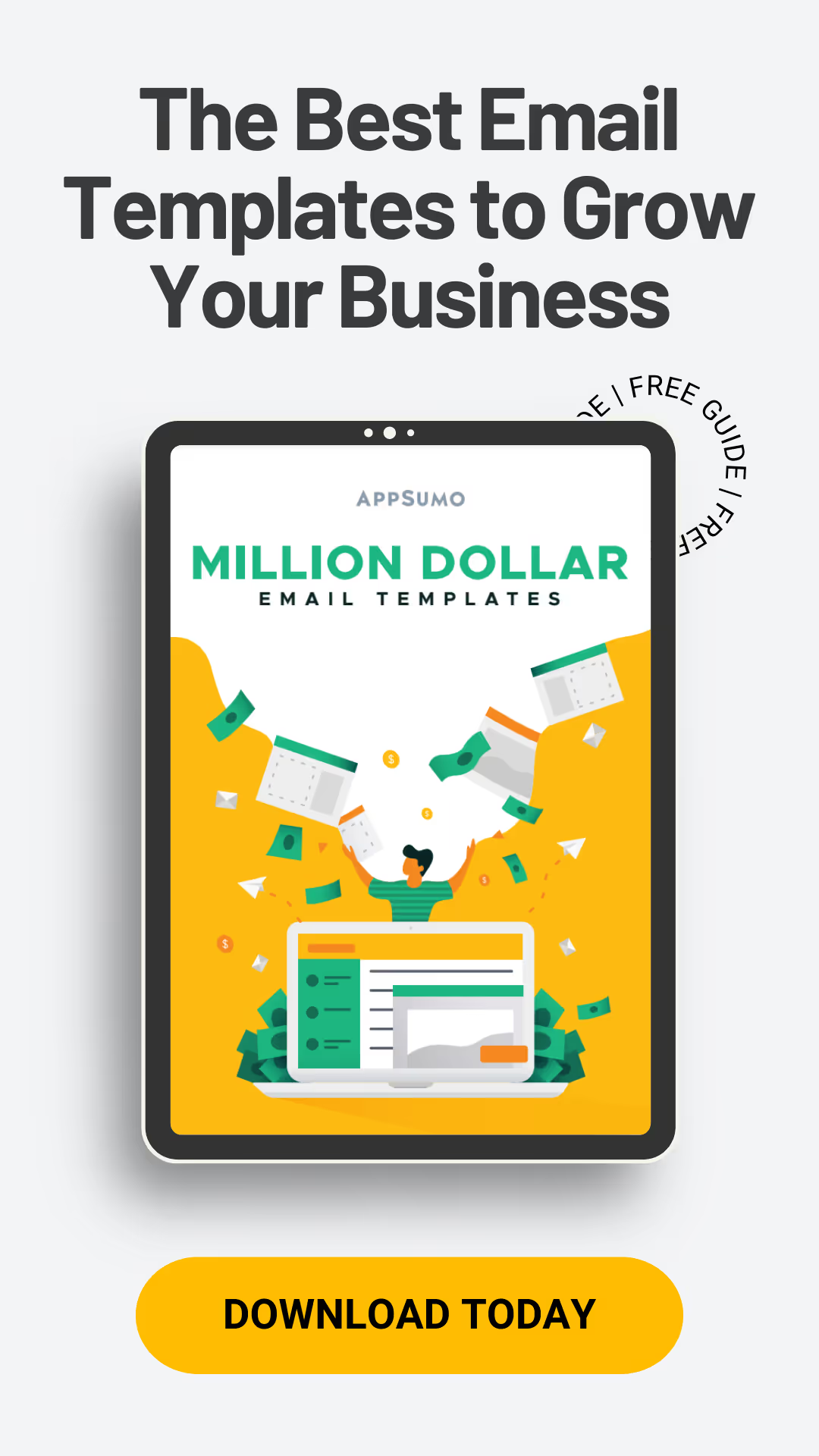Want to get the recognition you deserve?
This post is for you.
In this guide, I’ll share five steps to help you create and sell digital downloads like gangbusters, including:
Finished creating your product? Start listing it on AppSumo Marketplace!
Let’s begin.
1. Identify a laser-focused goal
Digital downloads are a saturated market. Just look at the number of competitors in your industry.
To start strong right out of the gate, set a laser-focused goal. Here’s a real-world example of what I mean.
Eman Zabi, founder of The Scribesmith, wanted to attract leads for her low-tier offers.
The reason?
She didn’t have the capacity to take on smaller businesses. Rather than turning them away, she decided to offer support that didn’t require her 1:1 time and at a lower cost, to boot.
In the end, she built the Launch Planner App.

Users who download the free app will enter a marketing funnel for Eman’s accessible offers, including a $750 strategy call session.
Similarly, Michelle Lewis wanted a faster way to acquire warm leads.
The CEO of Visibility Vixen already had her medium- and high-cost offerings in place. For her lower-cost item, she created the Podcast Pitch Kit, a $29 online course.
Do you want to earn extra sales on the side or build an email list for a specific marketing funnel?
Clarify your goal before creating your digital downloads.
Each goal will lead to different products and promotion strategies.
2. Build an engaging community
When you have an audience of fans, selling becomes easier.
Just ask any successful digital product creator.
These passionate followers will not only buy, but also promote it to their friends and families. It’s almost as if you have an army of brand advocates who sell for you!
When Elise Dopson started talking about freelancing on Twitter, she drew a crowd.

Many freelance writers began approaching her for advice.
After realizing she was sharing tips she wished she had known at the beginning of her career, Elise decided to launch Peak Freelance, a membership community for freelance writers.

On top of that, she and her co-founder, Michael Keenan, also sell digital downloads like email templates and content handbooks.
Since October 2020, Peak Freelance has grown to over 70 members.
Would Elise attract these members if she hadn’t built a community on Twitter? Maybe, but it would require more promotion work on her part.
Jimmy Daly, CEO of Superpath, seconds the audience-first approach.
He shares, “The bigger the audience, the easier it is to know what they want. Also, you have more people to sell to.”

How do you build your audience? Here are two popular ways to get started:
- Offer free content to grow your email list: Create unique and valuable content upgrades or lead magnets to get users’ email addresses. Build an email series to nurture these subscribers. When you’ve finished building, start promoting it to them.
- Participate in conversations on social media: Grow your Instagram following, drive high-targeted traffic from Quora, optimize your LinkedIn profile and engage with connections’ posts; you get the idea.
Pro tip: Summarize thought leaders’ content along with your thoughts and tag them.

3. Conduct research
It’s silly creating digital downloads on a whim.
These random bolts of inspiration rarely match your audience’s needs and desires.
After building an audience, put your research hat on and ask a lot of questions.
There are a couple of ways to go about your research process. Here are two ideas backed by examples.
(i) Look at what’s working on your website
Sarah Stromsdorfer, founder of My OT Spot, created her ebooks based on her most popular blog posts.

Since she’d written most of the content, these digital downloads require only a few weeks of light editing and formatting.
(ii) Ask your audience
As Jimmy from Superpath puts it (shown in step 2), the bigger the audience, the easier it is to know what they want.
Michelle didn’t immediately create her podcast kit after identifying her goal and building her community.
Instead, she asked her audience’s biggest struggles in a poll.
So start asking questions!
Send a survey, poll, or even an email with just this simple question,
“What was happening in your life that brought you to this [website/service etc.]?”
Note: This is inspired by Joanna Wiebe, founder of Copyhackers. Tweak it as you see fit.
Here’s another example. Check out this message a content marketing thought-leader sent me on LinkedIn.

Right?
It’s not the typical hard-selling message you usually get from a salesperson.
If anything, it’s the opposite. It creates a friendly vibe and starts a conversation.
This brings me to my next point:
Avoid selling at this stage. What you want is to gauge interest.
“It's similar to the whole ‘build in public’ concept, except you're building friends at the same time. A win-win! They'll likely become people willing to promote your digital products, too, if it's something they've been partially involved in.” – Elise Dopson, co-founder of Peak Freelance
Based on your audience’s answers, you’re a step closer to identifying the specific content and the format that best suits your audience’s needs.
When mom blogger Holly Nordenberg first started blogging, she sold meal plans and templates.
During research, she discovered that’s not what her audience (busy moms) wants, as these plans and templates require a significant amount of work.
What they really want? Digital downloads they can use immediately, ideally with little to zero effort.
4. Build an MVP and gather no-holds-barred feedback
Pop your knuckles, it’s time to create your digital products.
Pro tip: Build a minimum viable product (MVP).
Liz Bayardelle, blogger of The Stay Sane Mom, creates her digital downloads based on her needs as a mother. Since she makes up her target audience, the approach works.
After creating an MVP (which is usually a printable like a chore chart or checklist) on InDesign, she uses it for a few weeks and makes a few adjustments.
Next, she sends it to her inner circle for a test drive.
“Have at least one paid product and a corresponding funnel as soon as you can. You can get real-time data about what works (and what doesn’t) before driving traffic through a potentially faulty funnel or spending too much valuable time on an aspect of your business that doesn’t affect the bottom line.” – Liz Bayardelle, blogger of The Stay Sane Mom
In other words, aim for an 80% completion.
“Easy, lean, and fast. That’s what you’re looking for in the early stages of building.” – Eman Zabi, founder of Launch Planner App
The beauty of digital downloads like online courses and apps? You can always update them easily.
Early user feedback reduces the risk of expensive mistakes (e.g., unnecessary product iteration) down the road.
Here are a few sample questions when collecting feedback:
- What do you like most and least about [Digital product]?
- How would you describe the buying experience?
- How likely are you to recommend [Digital product]? Why?
Pro tip: Before promoting your product, go through the shopping process to catch potential errors.
Sophie Bowman, founder and CEO of Convert Your Followers, recommends using a different email address to purchase your digital download.
“Activate mystery shopper mode… on yourself! Note on the sales funnel and what needs to be tweaked to improve the buying experience.” – Sophie Bowman, founder and CEO of Convert Your Followers
Here’s an example.
Back when I was working at a startup, I had to set up an ecommerce store for our online courses.
We offered discounts to celebrate our inaugural launch.
After signing up for a new account and going through the process myself, I realized I’d forgotten to enable the coupon field.
I was relieved I caught this mistake on time. Otherwise, our three-person team would have to deal with an onslaught of emails from frustrated customers.
5. List digital downloads on popular marketplaces
It’s D-day — release your digital products into the wild!
Besides promoting it to your email list and on social media, what else can you do to get a bigger exposure?
List your digital products on third-party platforms.
Yes, these marketplaces can have a monthly fee or take a cut of your sales.
But hey, at least you don’t need to spend days and weeks continually generating traffic.
Here are five platforms to help you grow your reach.
(i) AppSumo Marketplace
Best for: SaaS and info products

Reach millions of passionate software users on AppSumo Marketplace.
It’s simple: Earn 95% of revenue when you bring a new customer to our marketplace, or 70% from returning customers we bring to you.
Here’s what companies have accomplished after selling their digital downloads on the AppSumo Marketplace:
- From 169 customers to 8,266 in 28 days: how Frase built the biggest AppSumo launch ever
- Are you launching a product? See how we made $450k in the first two months
- How we made $250,000 in one week: a guide for successful AppSumo promotion [update]
When you list on the AppSumo Marketplace, you’re spotlighting your product in front of over a million users.
Want to create even more buzz?
Get five reviews after your product goes live. You’ll get access to our marketing experts and skyrocket your sales further.
(ii) Easy Digital Downloads
Best for: WordPress users

Easy Digital Downloads is an ecommerce plugin that helps you sell digital files on your website. One small limitation is it only works on WordPress.
(iii) Gumroad
Best for: Apps and tutorials

Gumroad’s a favorite community of creators.
It’s easy to sell on the platform, especially if you have only a few digital products.
Due to the organizational structure, some users report it can be difficult if you’re trying to sell hundreds of products.
(iv) Podia
Best for: Community-based courses

Podia is synonymous with all things online learning.
If you’re looking for a customized platform for elearning and you want to access everything (e.g., listing digital downloads and messaging members) under the same roof, look no further.
(v) Etsy
Best for: Handmade goods

Etsy’s the place to go to when it comes to unique handmade items.
There is a small group of creators selling digital downloads, but they’re mostly lifestyle printables like art, planners, and craft patterns.
If you’re selling software tools, this might not be the best place.
Join AppSumo Marketplace to sell digital downloads today
We’ve covered a lot of steps and tips in today’s guide.
Let’s do a final recap:
- Identify a laser-focused goal. Earning passive income for a blog and building an email list for a specific marketing funnel will have different products and marketing strategies. Zero in on your specific goal!
- Build an engaging community. Selling becomes easier when you have an audience of fans who trust and love your work.
- Conduct research. Look at what’s working and talk to your audience. Most importantly, avoid selling at this stage.
- Build an MVP and gather no-holds-barred feedback. Aim for an 80% completion rate. Early user feedback will shape the remaining 20%.
- List digital downloads on popular marketplaces to leverage traffic and save time on building marketing campaigns.
If you’re:
- Creating a new digital product like a SaaS tool or an ebook
- Looking to improve it with early user feedback
- Tired of handling marketing all by yourself
- Dreaming of reaching millions of passionate users like entrepreneurs, founders, and marketers
… join us!
Earn 95% of revenue when you bring a new customer, or 70% from returning customers we bring to you.
Launch your hard-won digital product on the AppSumo Marketplace today.
And finally, get the recognition you deserve.




